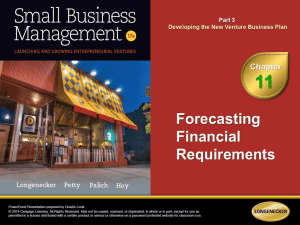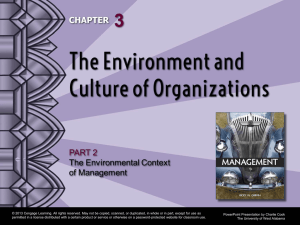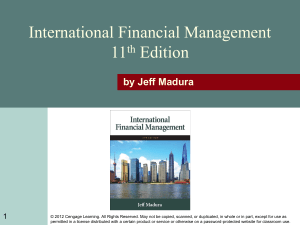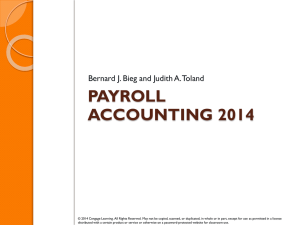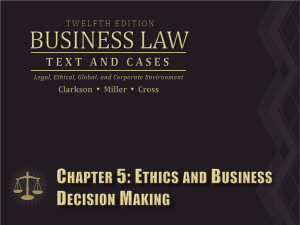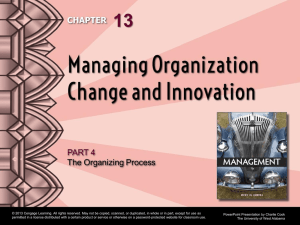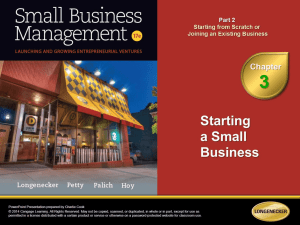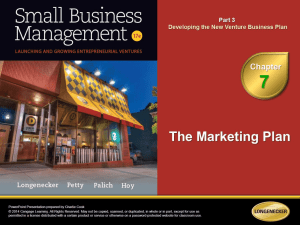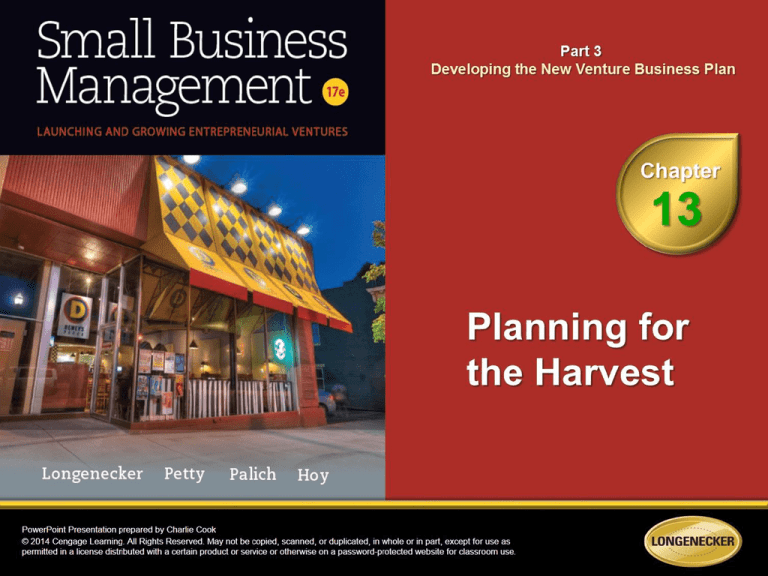
1. Explain the importance of having
a harvest, or exit, plan.
2. Describe the options available for harvesting.
3. Explain the issues in valuing a firm that is
being harvested and deciding on the method
of payment.
4. Provide advice on developing an effective
harvest plan.
© 2014 Cengage Learning. All Rights Reserved. May not be copied, scanned, or duplicated, in whole or in part, except for use as
permitted in a license distributed with a certain product or service or otherwise on a password-protected website for classroom use.
13–2
The Importance of the Harvest
• Harvesting (or Exiting)
The process used by entrepreneurs and investors to
reap the value of a business when they leave it.
The process involves:
Capturing value (cash value)
Reducing risk
Creating future options
© 2014 Cengage Learning. All Rights Reserved. May not be copied, scanned, or duplicated, in whole or in part, except for use as
permitted in a license distributed with a certain product or service or otherwise on a password-protected website for classroom use.
13–3
13.1
Methods for Harvesting a Business
© 2014 Cengage Learning. All Rights Reserved. May not be copied, scanned, or duplicated, in whole or in part, except for use as
permitted in a license distributed with a certain product or service or otherwise on a password-protected website for classroom use.
13–4
Selling the Firm:
Buyers’ Reasons for Purchasing a Firm
• Sales to Strategic Buyers
A purchase in which the value of the business is
based on both the firm’s stand-alone characteristics
and synergies that the buyer thinks can be created by
the strategic fit of the firm and a potential buyer.
• Sales to Financial Buyers
A purchase in which the value of the business is
based on the stand-alone cash generating potential of
the firm being acquired.
© 2014 Cengage Learning. All Rights Reserved. May not be copied, scanned, or duplicated, in whole or in part, except for use as
permitted in a license distributed with a certain product or service or otherwise on a password-protected website for classroom use.
13–5
Financial Acquisitions
Bust-Up
LBO
Build-Up
LBO
Types of
Leveraged
Buyouts (LBOs)
Management
Buyout (MBO)
© 2014 Cengage Learning. All Rights Reserved. May not be copied, scanned, or duplicated, in whole or in part, except for use as
permitted in a license distributed with a certain product or service or otherwise on a password-protected website for classroom use.
13–6
Choosing a LBO Firm for Acquisition
Characteristics of a
Potential LBO Firm
Steady
earnings
over time
Attractive
growth rate
for firm
Effective
management
team
© 2014 Cengage Learning. All Rights Reserved. May not be copied, scanned, or duplicated, in whole or in part, except for use as
permitted in a license distributed with a certain product or service or otherwise on a password-protected website for classroom use.
Assets
useful as
collateral
13–7
Selling the Firm: Buyers’ Reasons for
Purchasing a Firm (cont’d)
• Sales to Employees
Employee Stock Ownership Plan (ESOP)
A method by which a firm is sold either in part or in total to its
employees.
– Employees retirement contributions are used to purchase
shares in the firm.
– Frequently is exit method of last resort.
– Motivates employee-owners to perform.
© 2014 Cengage Learning. All Rights Reserved. May not be copied, scanned, or duplicated, in whole or in part, except for use as
permitted in a license distributed with a certain product or service or otherwise on a password-protected website for classroom use.
13–8
Leveraged ESOP Buyout Process
1. Employer firm
guarantees payment
of loan.
Employer
Firm
5. Employer firm
makes annual
contribution for
employee stock
purchases.
3. Cash from loan
is used to buy
owner’s stock.
Lender
2. ESOP trust
borrows money
from lender.
6. ESOP trust
makes payment
on loan.
ESOP
Trust
Selling
Owner
© 2014 Cengage Learning. All Rights Reserved. May not be copied, scanned, or duplicated, in whole or in part, except for use as
permitted in a license distributed with a certain product or service or otherwise on a password-protected website for classroom use.
4. Stock is sent to
ESOP trust for
benefit of employees.
13–9
Selling A Business in Difficult Times
Clean up
the books
Keep revenue
strong
Selling A
Business
Consider your
sector and market
© 2014 Cengage Learning. All Rights Reserved. May not be copied, scanned, or duplicated, in whole or in part, except for use as
permitted in a license distributed with a certain product or service or otherwise on a password-protected website for classroom use.
13–10
Distributing the Firm’s Cash Flows
• Harvesting by Withdrawing Firm’s Cash
Advantages:
Retain control of firm while harvesting investment.
No need to seek a buyer or incur expenses associated with
sale of business
Disadvantages
Loss of development potential and opportunities
Tax disadvantages of cash withdrawal
Requires patience to siphon off cash slowly
© 2014 Cengage Learning. All Rights Reserved. May not be copied, scanned, or duplicated, in whole or in part, except for use as
permitted in a license distributed with a certain product or service or otherwise on a password-protected website for classroom use.
13–11
Harvesting by Going Public
• Initial Public Offering (IPO)
Benefits of the sale of shares of stock to the public:
Signals to investors that a firm is a quality business and will
likely perform well in the future.
Provides access to more investors when the firm needs to
raise capital to grow the business.
Helps create ongoing interest in the company and its
continued development.
Makes firm’s stock more attractive as incentive pay to key
personnel.
© 2014 Cengage Learning. All Rights Reserved. May not be copied, scanned, or duplicated, in whole or in part, except for use as
permitted in a license distributed with a certain product or service or otherwise on a password-protected website for classroom use.
13–12
Harvesting by Going Public
• Setting the Stage for an IPO
1. Maintain an accounting process that cleanly
separates the business from the entrepreneur’s
personal life
2. Select a strong board of directors that can and
will offer valuable business advice
3. Manage the firm so as to produce a successful
track record of performance
© 2014 Cengage Learning. All Rights Reserved. May not be copied, scanned, or duplicated, in whole or in part, except for use as
permitted in a license distributed with a certain product or service or otherwise on a password-protected website for classroom use.
13–13
13.2
IPOs 2009–2012
© 2014 Cengage Learning. All Rights Reserved. May not be copied, scanned, or duplicated, in whole or in part, except for use as
permitted in a license distributed with a certain product or service or otherwise on a password-protected website for classroom use.
13–14
Going Public: The IPO Process
1. The firm’s owners decide to go public.
2. If not already completed, an audit of the last three years financial
statements is conducted.
3. An investment banker is selected to guide the IPO process.
4. An S-1 registration is drafted and filed with SEC.
5. Management responds to suggested comments by the SEC, and
issues a Red Herring/Prospectus.
6. Firm goes “on the road” explaining its attributes to investors.
7. On the day before public offering, an offering price is decided upon.
8. Offering the stock to the public and seeing how it is received.
© 2014 Cengage Learning. All Rights Reserved. May not be copied, scanned, or duplicated, in whole or in part, except for use as
permitted in a license distributed with a certain product or service or otherwise on a password-protected website for classroom use.
13–15
Private Equity Recapitalization
• Private Equity Recapitalization
Private equity investors provide additional financing to
a business that allows an entrepreneur to cash out a
portion of his or her investment, while possibly
continuing to operate the business
• Factors in the Transfer of Family-Owned Firms
Liquidity for exiting family members
Continued financing for company growth
Retaining control of the firm by
the younger family member
© 2014 Cengage Learning. All Rights Reserved. May not be copied, scanned, or duplicated, in whole or in part, except for use as
permitted in a license distributed with a certain product or service or otherwise on a password-protected website for classroom use.
13–16
13.3
Private Placement—An Illustration
© 2014 Cengage Learning. All Rights Reserved. May not be copied, scanned, or duplicated, in whole or in part, except for use as
permitted in a license distributed with a certain product or service or otherwise on a password-protected website for classroom use.
13–17
Firm Valuation and Payment Methods
• The Harvest Value
Opportunity cost of funds is the rate of return that
could be earned on another investment of similar risk
• Harvest Value/Market Comparable Valuations
Establishing the value of a privately held company
based on the value of a similar or comparable publicly
traded company.
Multiple of earnings method is frequently used.
© 2014 Cengage Learning. All Rights Reserved. May not be copied, scanned, or duplicated, in whole or in part, except for use as
permitted in a license distributed with a certain product or service or otherwise on a password-protected website for classroom use.
13–18
Harvesting: The Method of Payment
• Payment Alternatives
Cash
Immediate and stable in value
Tax liability consequences
Stock
Purchaser: protection from liabilities
Seller: immediate but uncontrollable in value
Seller: potential problems with disposal of stock
Merger with Purchasing Firm
Purchased firm is absorbed into purchasing firm
© 2014 Cengage Learning. All Rights Reserved. May not be copied, scanned, or duplicated, in whole or in part, except for use as
permitted in a license distributed with a certain product or service or otherwise on a password-protected website for classroom use.
13–19
Developing an Effective Harvest Plan
• Anticipate the Harvest
Manage for the long-term
Avoid playing the harvest game
Prepare by separating your “self” from the firm
• Expect Conflict—Emotional and Cultural
Strains of selling own business
Personal ties to the business after sale
• Get Good Advice
Advisors with harvest transaction experience
Other entrepreneurs who have sold their firms
© 2014 Cengage Learning. All Rights Reserved. May not be copied, scanned, or duplicated, in whole or in part, except for use as
permitted in a license distributed with a certain product or service or otherwise on a password-protected website for classroom use.
13–20
Developing a Harvest Plan (cont’d)
• Understand What Motivates Your Exit
Motives for exiting:
Money
Independence
Health of the company
Your management team
An heir apparent taking over
Personal identity and the
business itself
Avoid “seller’s remorse”
© 2014 Cengage Learning. All Rights Reserved. May not be copied, scanned, or duplicated, in whole or in part, except for use as
permitted in a license distributed with a certain product or service or otherwise on a password-protected website for classroom use.
13–21
What’s Next?
• Whatever you decide to do, do it with passion
and let your life benefit others in the process.
© 2014 Cengage Learning. All Rights Reserved. May not be copied, scanned, or duplicated, in whole or in part, except for use as
permitted in a license distributed with a certain product or service or otherwise on a password-protected website for classroom use.
13–22
Key Terms
harvesting (exiting)
business broker
leveraged buyout (LBO)
bust-up LBO
build-up LBO
management buyout (MBO)
employee stock ownership plan (ESOP)
seller financing
double taxation
initial public offering (IPO)
private equity recapitalization
opportunity cost of funds
© 2014 Cengage Learning. All Rights Reserved. May not be copied, scanned, or duplicated, in whole or in part, except for use as
permitted in a license distributed with a certain product or service or otherwise on a password-protected website for classroom use.
13–23




